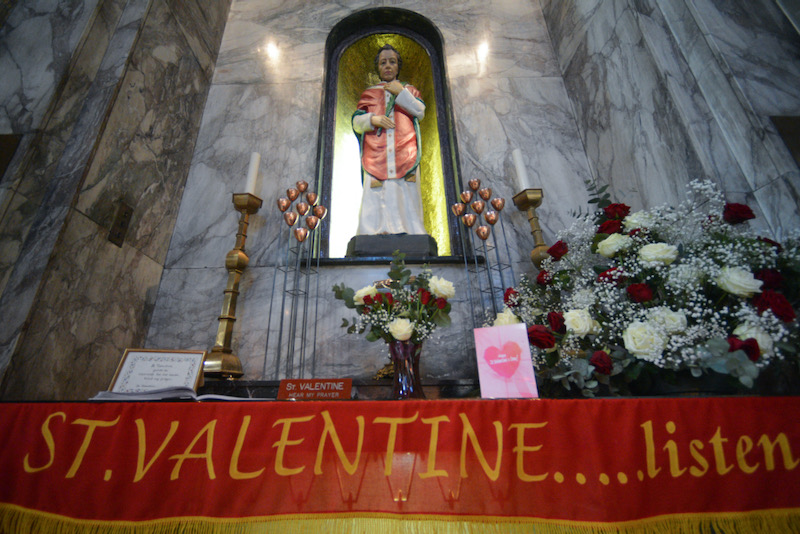Bunches of over-priced red roses, boxes of chocolates and heart-adorned greetings cards strategically located near checkouts. It can only mean one thing: St Valentine’s Day is approaching.
Falling on 14 February, its association with love and romance ensures that it’s one of only a handful of saints’ feasts whose date can be immediately identified by the average person in the street. It’s all too easy to be deeply cynical about our hyper commercialised and deeply sentimental celebration of Valentine’s holy day. But read on: you’ll find that there’s precious little about St Valentine to justify his connection with amorous couples; that observance of the feast in post-Christian, twenty-first century Britain is far from being a modern secularisation of a venerable feast; and that QI-watching types who delight in “I think you’ll find” comments about the influence of the ancient, pagan past on the celebration of Christian holy days might, for once, be onto something.
Other than that he was martyred in Rome in the mid-third century, not that much is known about the historical St Valentine. Or should that be the St Valentines? Early Christian sources identify two holy martyrs called Valentine who suffered for their faith in the Eternal City. The first was a priest executed and buried outside the city walls on the Flaminian Way (a major highway leading to and from Rome), the other a bishop of Terni, a small city 60 or so miles north east of Rome. The Roman Church initially tried to hedge its bets, giving both a feast on 14 February. This didn’t cut it with the Bollandists, a group of scholarly Belgium Jesuits who have been tussling with the finer points of hagiography since the seventeenth century, who concluded that the two saint Valentines were in fact one and the same.
Evidence for veneration of St Valentine is very ancient indeed. Possibly as early as the pontificate of Pope Julius I (337-352), a major church was built above his tomb near the Flaminian Way and throughout the Middle Ages was on the must-see list of pilgrims visiting the Holy City.
Devotion to Valentine spread across western Europe, reaching these shores no later than the eighth century. His feast was celebrated at churches great and small, though if the evidence of English monastic calendars is anything to go by, confusion about Valentine’s precise identity persisted until the eve of the Reformation, the saint sometimes being called a priest, other times a bishop. Though his cult remained firmly focused on Rome, Valentine’s relics were widely disseminated, some finding their ways into the collections of several English monasteries. In art, he was depicted as a bishop, sometimes carrying a palm to indicate his status as a martyr.
Miracles and heroic deeds were attributed to Valentine. According to the Golden Legend, a collection of saint’s lives written by Jacobus de Voragine, a thirteenth-century Italian friar, “Valentine never failed by shunning martyrdom, he struck hard by putting down idolatry, he defended his faith by confessing it, he conquered by suffering.” But you’ll look in vain for any mention of the saint in connection with love.
Indeed, there are sound grounds to believe that Valentine’s amorous associations are down to the forces of the nature, the general friskiness brought about by the lengthening days and the first signs of spring. According to a tradition going back to at least the mid-fourteenth century and Geoffrey Chaucer, 14 February was the day upon which birds would choose their mates. Humans emulated these love birds, John Lydgate, a monk at Bury St Edmunds, commenting that on St Valentine’s Day it was the custom of Englishmen, “To look and search Cupid’s calendar/And choose their choice with great affection.”
The letters of the Paston family, Norfolk gentry, record the selection of “Valentines”. This custom was maintained into the early sixteenth century, Sir Henry Willoughby, a Warkwickshire gent, bestowing cash gifts to his Valentine. (Do not try this today! However stuck you are for a gift idea, you’ll undoubtedly save yourself a lot of grief by at least pretending to have made an effort and buying some discounted chocolates, a bottle of cheap Prosecco and odourless roses. It’s the thought that counts, isn’t it?)
Counter Reformation Catholicism placed great emphasis on early Roman saints who had died for their faith and Valentine’s veneration prospered in Catholic countries during the sixteenth and seventeenth centuries. But his Roman associations, martyrdom and colourful legend ensured that Valentine’s feast was purged from the calendar of the Protestant Church of England. The specialness of the day for courting couples proved much more resilient.
Godly Reformers, ever eager to expose papist “idolatry” and pseudo-paganism, would have been overcome by a fit of self-righteous rage and delight had they been aware of one possible explanation St Valentine’s association with love. The saint’s feast coincides with the ancient Roman festival of the Lupercalia. Observed between 13-15 February, it was strongly connected with fertility. According to the Oxford Classical Dictionary, its celebration “included odd rites”. Two youths, naked except for goatskin loincloths, ran around the Palatine Hill, striking bystanders, especially young women, with goatskin thongs. Perhaps it’s just me, but that sounds like a lot of fun!



 Loading ...
Loading ...
What do you think?
You can post as a subscriber user ...
User comments (0)